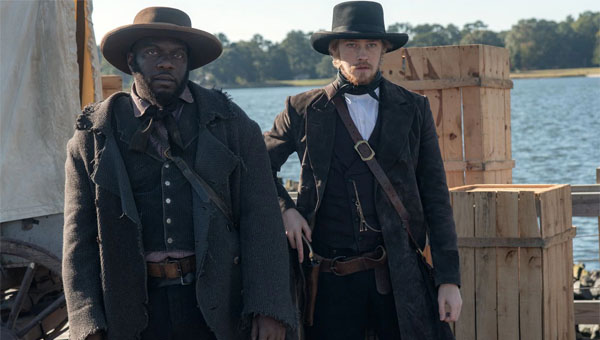By Yvonne Sam
Contributing Columnist
 The movie Harriet — the first feature length film to capture the most quintessential female abolitionist, suffragist and activist in American history — may have been succinctly used by Hollywood to propagate longstanding myths, playing out in our culture. One such example is the fictional bounty hunter named Bigger Long, played by Omar Dorsey.
The movie Harriet — the first feature length film to capture the most quintessential female abolitionist, suffragist and activist in American history — may have been succinctly used by Hollywood to propagate longstanding myths, playing out in our culture. One such example is the fictional bounty hunter named Bigger Long, played by Omar Dorsey.
Although the character is fictional, the name nevertheless alludes to male sexuality, the fear of which, in particular, has been a core reason for the subjugation of Black American males. One would not be surprised if “dong’ was replaced by “long” to throw viewers off the track, a clear plan of subterfuge.
Perhaps the directors/producers should be called upon to clarify/justify the appellation, or the origin of the nomenclature, so out of context with slave names existing during that period. The word is that every Black man has a large, long phallus.
Historical descriptions of Black men show them as being animalistic; sub-human and lust-driven; and also included the Black man as a “sexual superman”, with a male organ larger than the white man, and increased potency.
Intensification of the perception of Black male obsession with white females, was often used to justify lynching of Black males. Such an inference concludes that Black men are a sexual threat to society and are prone to raping white women.
In fact, Black sexuality can be termed a national terror. This particular type of stereotyping has been called “sexual threat” or “sexual racism”.
Bigger Long (Dong) continuously meanders through the countryside looking for the heroine, Harriet, all the while hoping that he can utilize the money to buy more time with white prostitutes.
Such a concept is also vividly portrayed in the 1915 film, Birth of a Nation, produced by D. W Griffith, wherein Blacks are shown to have savage bodies, savage minds and the object of desire of a ‘Black’ is a white female goddess.
The central Black character, Gus, a plantation hand, aggressively hounds a white female, who ultimately jumps to her death to escape his amorous advances. Gus is ultimately tried and killed by the Klu Klux Klan, who are depicted as heroes in the movie.
So the idea of the lubricious Black male and his giant phallus has been used to perpetuate the objectification and brutality of African American men.
In her 1977 book, Big Bad Wolves: Masculinity in the American Film, Joan Mellen took Melvin Van Peebles, the filmmaker and director of Sweet Sweetback’s Baadasssss Song, to task for “marrying his criticism of racial injustice in America to the myth of the inexhaustible sexuality of the Black male, refurbishing the old racist stereotype of the ‘buck’, the Black stud…”. Sweetback is nothing more than an embodiment of how white society has fantasizedBblack sexuality.
Pervasive racist media further alludes to an anxiety that white men feel about the Black phallus and what it represents — by creating a sexual monster, they had created something that needed to be controlled and feared.
Such an anxiety can find connection in the revulsion that the lynch mob in Glendora, Mississippi, in the 1950’s, felt for Emmett Till when he whistled at Carolyn Bryant, a white woman.
Of particular note, is the fact that during the rape trial of basketball star, Kobe Bryant, and former boxing champion, Mike Tyson, the size of their male organs were sometimes hinted at in some publications.
Across the field of specific research on the myth of the Black phallic body, critics and academic theorists agree on what has always defined Black men. It is primarily imagined in two specific ways: first, in terms of its hypersexual power, because the penis is seen as over-large; and second, the Black body is read as potentially dangerous, because of its musculature and physical strength.
The Black male body is a site — a location; a sight — a visible entity of physical excess; and a fright — feared by white men. Frantz Fanon said the measurement between Black and white sexual anatomies is unanswerable; nevertheless, the Black body is loaded with exaggeration.
The name Bigger Long epitomizes male masculinity, and depicts Hollywood’s awareness of what has always defined Black men. It is apparent that Hollywood, seemingly bent on recounting history from the perspective of a Black female slave turned abolitionist, crossed the line or juxtaposed what was “history” and what can be termed continuing “the story”, via their naming and depiction of the male hero.
Such a cleverly-veiled cinematic move is not immediately apparent, but gradually arrived at following more detailed attention as the plot unfolds. In the film, Harriet, not just one story has been told.
Yvonne Sam, a retired Head Nurse and Secondary School Teacher, is Vice-president of the Guyana Cultural Association of Montreal. A regular columnist for over two decades with the Montreal Community Contact, her insightful and incursive articles on topics ranging from politics, human rights and immigration, to education and parenting have also appeared in the Huffington Post, Montreal Gazette, XPressbogg and Guyanese OnLine. She is also the recipient of the Governor General of Canada Caring Canadian Citizen Award.
 Pride News Canada's Leader In African Canadian & Caribbean News, Views & Lifestyle
Pride News Canada's Leader In African Canadian & Caribbean News, Views & Lifestyle






Worst rape of Black American history ever.